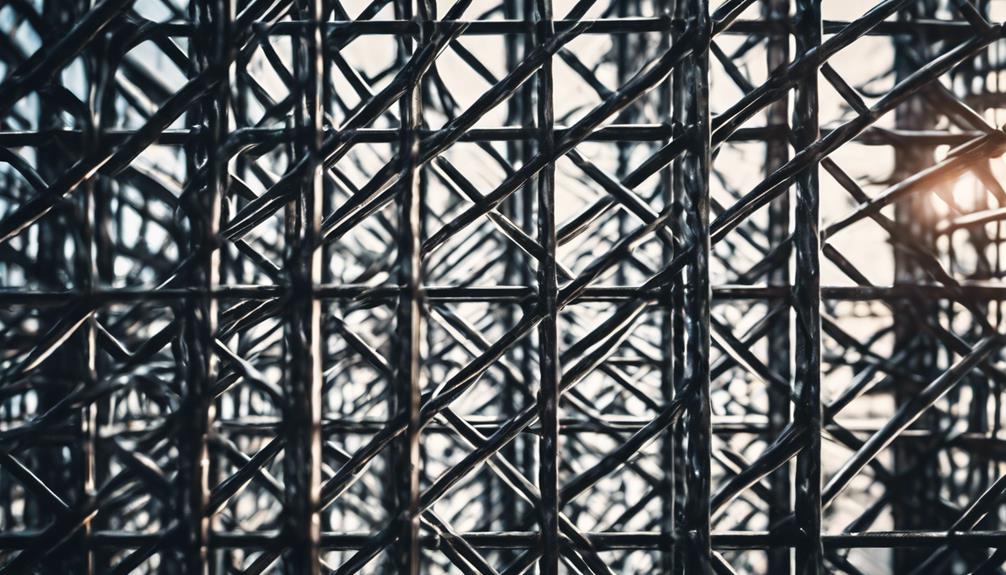Industrial steel structures provide exceptional strength with high compressive and tensile strength, a favorable strength-to-weight ratio, and excellent ductility. They possess outstanding resilience, stability, and resistance to expansion. Durability is guaranteed through resistance to corrosion, structural stability, and minimal repair needs. Steel structures excel in impact resistance while maintaining robust structural integrity, making them reliable for heavy loads. Their longevity exceeds 50 years, with design flexibility and sustainability. Fire and corrosion protection are enhanced with inherent resistance to high temperatures and barrier coatings. Steel’s inorganic composition naturally resists pests, eliminating the need for additional treatments. Discover more about steel’s unmatched attributes.
Key Takeaways
- Steel offers exceptional strength and resilience for industrial structures.
- Durability is ensured through corrosion resistance and high-quality materials.
- Structural integrity is maintained with impact resistance and stability.
- Steel buildings have a lifespan of over 50 years, promoting sustainability.
- Fire and corrosion protection, along with pest resistance, enhance longevity.
Steel Strength Attributes
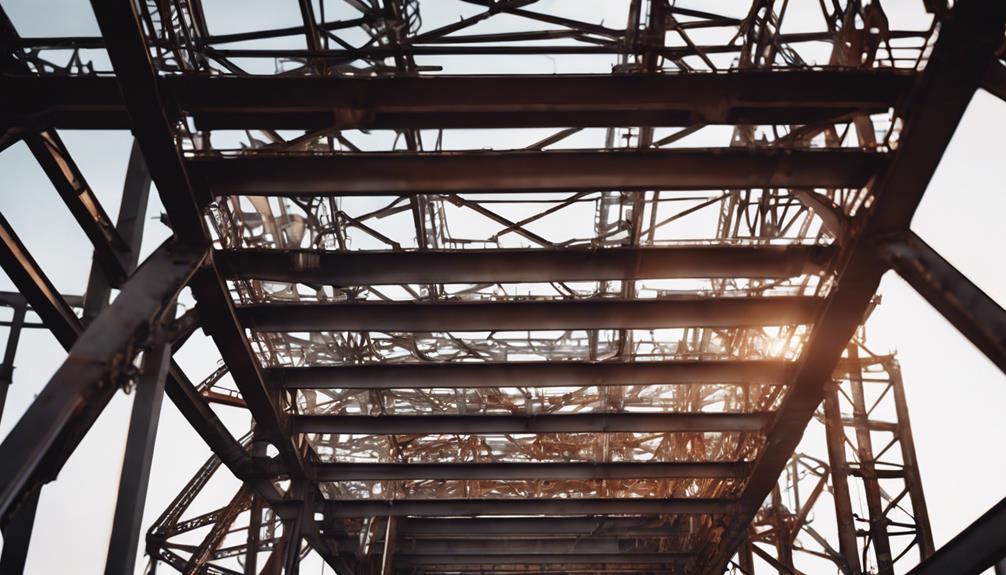
Steel’s exceptional strength characteristics play a pivotal role in the performance and reliability of industrial steel structures. When it comes to building construction, the steel strength attributes are crucial. Industrial steel structures require materials that can withstand heavy loads and structural movements, which is where steel excels. The high compressive and tensile strength of steel make it an ideal choice for such applications. Additionally, the high strength-to-weight ratio of steel ensures that these structures can bear significant loads without adding unnecessary weight.
Structural steel for building construction must possess excellent ductility to allow for bending without breaking under extreme conditions. This attribute is important in ensuring the safety and longevity of industrial steel structures. Furthermore, steel’s stability and resistance to expansion and contraction further contribute to the long-term structural integrity of these buildings. The predictability of steel in maintaining its basic properties and chemical composition under stress also makes it a preferred material for Industrial Steel Structures, providing reliability and peace of mind to builders and occupants alike.
Resilience in Steel Structures
The exceptional resilience demonstrated by steel structures is a proof of their capability to withstand extreme conditions and natural disasters, making them a reliable choice for industrial and commercial building projects.
Industrial steel structure suppliers recognize the importance of resilience in steel buildings, offering designs that prioritize safety and longevity. Stainless steel structure building further enhances resilience by providing corrosion resistance, guaranteeing durability in various environments.
Despite their strength, steel building prices remain competitive due to efficient manufacturing processes and the material’s recyclability, making them a cost-effective choice for resilient structures.
The ability of steel structures to bend without breaking, thanks to their flexibility and ductility, ensures they can withstand high-stress situations and recover their original shape, maintaining structural integrity over time. This resilience not only guarantees the safety of occupants but also contributes to the long-term performance and sustainability of industrial steel buildings.
Durability Factors of Industrial Steel
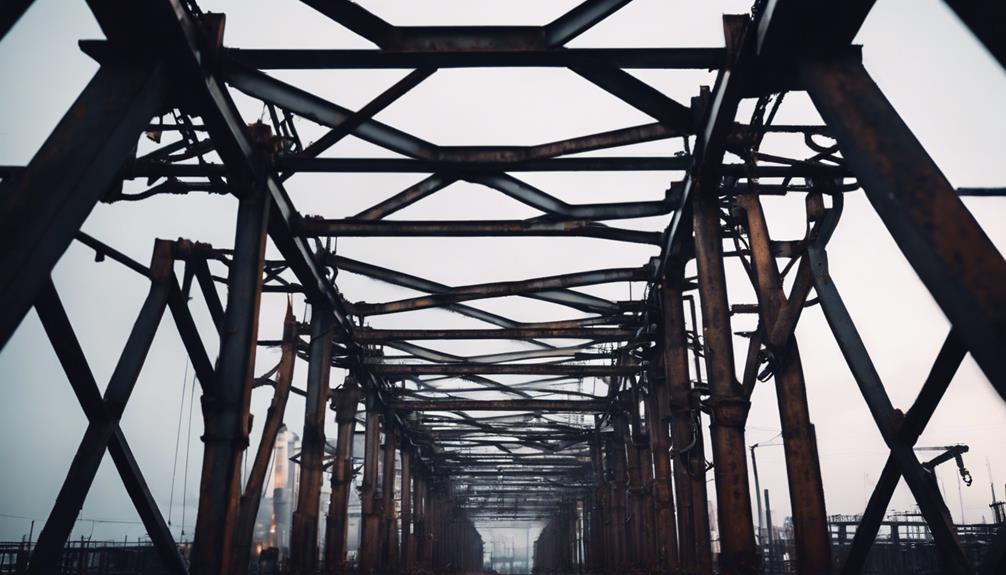
Engineered with cutting-edge technology and high-quality materials, industrial steel structures boast exceptional durability factors that guarantee longevity and reliability in challenging environments. These structures are specifically designed to resist corrosion, ensuring they maintain their integrity and strength over the long term, even in harsh conditions.
The steel used in industrial construction undergoes extensive testing to meet stringent durability and strength standards, ensuring it can withstand heavy loads and extreme weather conditions without compromising its structural stability. Additionally, surface treatments like galvanizing provide an extra layer of protection against rust and corrosion, further enhancing the durability of industrial steel structures.
Impact Resistance of Steel
Exhibiting exceptional resistance to impact forces, industrial steel structures are renowned for their ability to withstand heavy impacts in environments prone to dynamic loads. Steel’s high impact resistance stems from its inherent strength and ductility, allowing it to absorb and distribute impact energy efficiently. This quality reduces the risk of structural damage, making steel structures suitable for areas where machinery, vehicles, or equipment may exert significant forces.
The design of industrial steel structures takes into account the need to withstand impact without compromising structural integrity. By offering enhanced safety for occupants and equipment within industrial facilities, impact-resistant steel structures guarantee a secure environment. Additionally, steel’s resilience to impact not only ensures the safety of individuals and assets but also contributes to the long-term durability of the structure, requiring minimal maintenance over time. Overall, the impact resistance of steel plays an essential role in maintaining the structural stability and safety of industrial facilities.
Structural Integrity of Steel
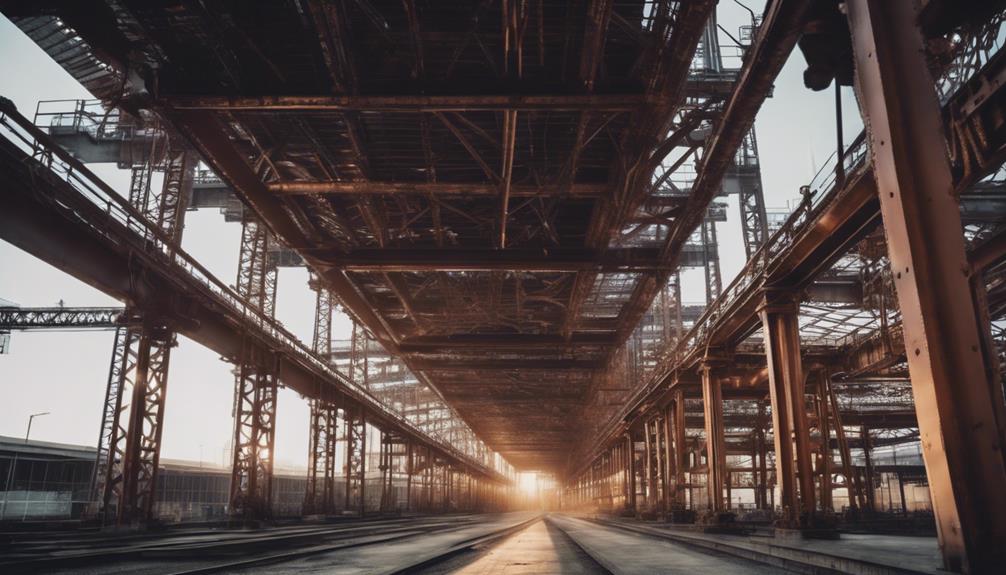
Guaranteeing robust structural integrity, steel remains a stalwart choice for withstanding extreme conditions and heavy loads in industrial settings. Steel structures exhibit remarkable resilience, maintaining their integrity even when subjected to severe forces such as earthquakes and hurricanes.
This resilience is attributed to steel’s high strength-to-weight ratio, which provides structural stability and durability over time. Additionally, steel’s inherent resistance to corrosion and rust further enhances its long-term structural integrity, making it a reliable choice for industrial applications where longevity is paramount.
Engineers employ advanced techniques and stringent quality control measures during the design and construction of steel structures to secure their ability to withstand heavy loads and forces, thereby safeguarding their structural stability in demanding industrial environments. The continuous emphasis on structural integrity in the use of steel underscores its reputation as a durable and dependable material for industrial construction projects.
Longevity of Steel Buildings
Steel buildings showcase exceptional longevity, standing as enduring evidence to the durability and structural integrity of steel in industrial applications. With a lifespan of over 50 years, steel structures guarantee long-term durability and robustness. Proper maintenance practices can even extend this lifespan to well over a century, highlighting the resilience of steel in construction.
One key factor contributing to the longevity of steel buildings is their resistance to corrosion and rust, which minimizes the need for frequent repairs and upkeep. Additionally, the design flexibility of steel structures allows for easy upgrades and modifications over time, further enhancing their longevity in industrial settings.
Despite the passage of time, steel buildings maintain both their aesthetic appeal and structural strength, making them a reliable choice for long-term industrial use. The ability of steel structures to withstand the test of time underscores their practicality and sustainability in the construction industry.
Sustainable Steel Construction
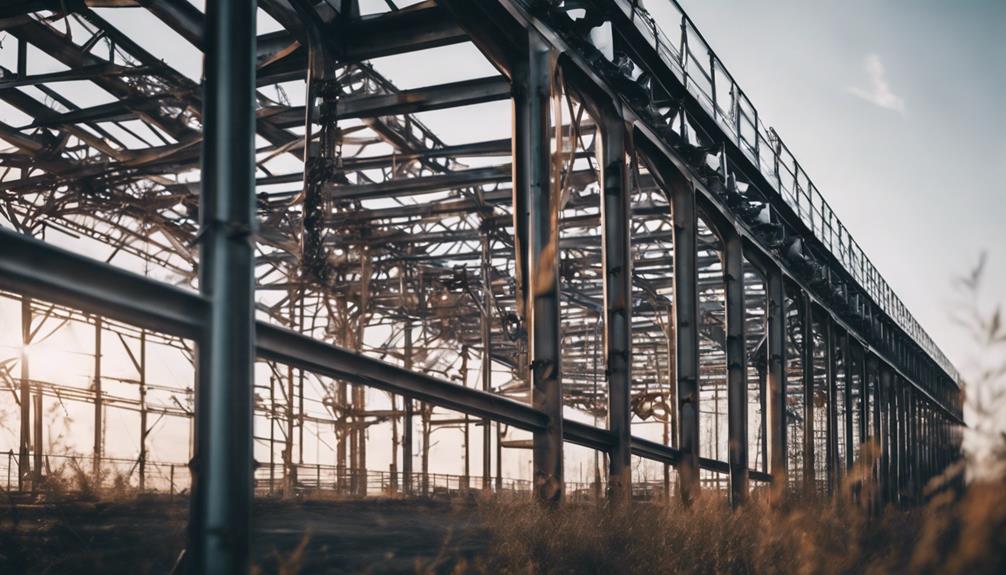
In the domain of industrial construction, the focus on sustainability has propelled the adoption of innovative practices, particularly in the efficient utilization of steel for structural projects. Sustainable steel construction embraces the principles of reducing waste through the use of recycled steel materials in industrial structures. This approach allows for the disassembly and reuse of steel structures, promoting a circular economy within the construction industry.
Steel’s exceptional recyclability rate of up to 90% further solidifies its position as a highly sustainable choice for industrial building projects. The energy-efficient nature of steel structures not only enhances their durability but also contributes significantly to reducing carbon emissions during both the construction and operation phases.
In addition, sustainable steel construction practices align seamlessly with green building standards such as LEED, emphasizing environmental stewardship and responsible resource management in industrial projects. By incorporating these sustainable practices, industrial steel structures can not only withstand the test of time but also contribute positively to the environment.
Steel’s Fire Resistance
The remarkable ability of steel structures to withstand high temperatures is a critical aspect of their design, particularly in ensuring occupant safety in industrial buildings. Steel’s inherent fire resistance lies in its capability to maintain structural integrity even in extreme heat conditions. This property is essential for preventing structural collapse during a fire, safeguarding lives and minimizing property damage.
Steel’s high melting point and low thermal expansion further enhance its fire-resistant properties, allowing it to perform reliably under intense heat exposure. The fire resistance of steel structures is paramount in meeting safety standards and regulations for industrial buildings. Designing with steel offers a distinct advantage in fire-prone environments, as it provides a robust and dependable solution for protecting occupants and assets.
Engineers and architects prioritize steel’s fire resistance when planning industrial structures, acknowledging its pivotal role in ensuring the overall safety and longevity of the building. By leveraging steel’s exceptional performance under fire conditions, industrial facilities can better mitigate risks and enhance their resilience to potential disasters.
Corrosion Protection in Steel

Corrosion protection is a critical consideration in enhancing the longevity and performance of industrial steel structures. To combat corrosion, various methods are employed, with barrier coatings like paint being a common choice to isolate the steel from water and oxygen.
Zinc coatings, such as galvanized steel, are particularly effective as they provide sacrificial and barrier protection against corrosion in industrial settings. Properly designed steel structures undergo rigorous laboratory and field exposure tests to guarantee they offer excellent service life and corrosion resistance.
Building codes also mandate that steel structures must either tolerate corrosion or be adequately shielded against it to secure long-term durability in industrial applications. Implementing corrosion protection measures not only helps maintain the structural integrity of steel structures but also prevents degradation caused by environmental elements, ultimately prolonging their lifespan and enhancing their overall performance.
Pest Resistance in Steel Structures
Steel structures present a formidable barrier against pests like termites, thanks to their inherent inorganic composition. This natural resistance is a significant advantage in industrial construction, as it eliminates the risk of structural damage caused by pests.
Steel framing, commonly used in industrial structures, meets termite-resistant construction requirements, ensuring long-term durability. Unlike wood, steel construction does not require costly annual termite treatments, saving on maintenance expenses over time. The inorganic nature of steel makes it a reliable choice for pest-resistant industrial buildings, providing peace of mind to property owners.
Cold-formed steel, specifically designed for industrial applications, offers an additional layer of protection against pest infestations. Overall, the pest resistance of steel structures contributes to their strength and longevity, making them a practical and cost-effective solution for industrial construction projects.
Frequently Asked Questions
What Is the Durability of Steel Structures?
The durability of steel structures lies in their exceptional resistance to corrosion, rust, and deterioration, ensuring longevity and reliability. Steel’s ability to withstand harsh conditions, including extreme weather and seismic events, highlights its exceptional durability.
What Are the Strengths of Structural Steel?
Structural steel boasts a high strength-to-weight ratio, making it a preferred choice for tall buildings and industrial structures. Its exceptional strength, resistance to fire and weather damage, and ability to withstand natural disasters highlight its reliability and longevity.
How Durable Are Steel Buildings?
Steel buildings demonstrate exceptional durability, highlighting resilience against various environmental factors, including corrosion, fire, pests, and extreme weather conditions. Their robust nature guarantees long-term structural integrity, minimal maintenance needs, and extended lifespan.
What Is the Durability of Metal?
Metal, particularly steel, is highly durable, showcasing resistance to corrosion, rust, and degradation over time. Its structural integrity and longevity make it a reliable choice for various applications, providing cost-effectiveness and sustainability through its ability to withstand wear and tear.
Conclusion
To summarize, industrial steel structures possess exceptional strength, resilience, and durability due to their inherent attributes.
Steel’s high impact resistance, structural integrity, fire resistance, corrosion protection, and pest resistance make it a sustainable choice for construction projects.
The combination of these factors guarantees that steel structures can withstand various environmental challenges and maintain their structural integrity over time, making them a reliable and long-lasting option for industrial applications.

